An Ontology-Based Knowledge Modelling for a Sustainability Assessment Domain
Abstract
:1. Introduction
2. Literature Review
2.1. Frameworks
2.2. Indicators
2.3. Measures and Metrics
2.4. Discussion
2.5. Attempts to Knowledge Systematisation in the SA Domain
3. Knowledge Model for Sustainability Assessment Domain
3.1. Domain Analysis
- The leading domain of usage is shown in the majority of analysed approaches [1,3,9,14]. Often, the measures, frameworks and indicators are described and affixed by case studies [10,21] that serve as an indication to establish the fields of application. Moreover, possible areas of usage are also provided [49,62]. To provide a basic knowledge of approach destiny may help the end-users or business entities with the selection of a particular form of the solution. Various existing domains distinguish the practical application of analysed approaches. Commonly, they cover purchasing [49], production [81], supply management [14,82], or different forms of resources usage [11,43,83]. There are few solutions without identification a specified domain [12,27,80]. Continuously, new areas are added depending on market demands. The remaining domains refer to the tourism sector [40], SMEs sector [84] and food and housing [81]. The extended examples are provided in the comparative analysis placed in supplementary materials (see comparison_analysis.xls and taxonomy.xls). Limiting only to identified domains or the lack of given ones does not cross through the usage but informs of the verified areas of practical application.
- The aim of the approach conveys the short description of the main features, objectives and assumptions. It was conceived on the basis of the analysis of the paper’s content. This property provides the key knowledge of each of the selected solutions. To characterize a given set of approaches the main features are included, especially distinguishing a given set. The set of indicators points out of the activities referring to evaluation of a degree of products [85], operations [43], whereas the set of measures emphasizes the basic background of measurements, including production [49] or processes [62]. Generally, the framework’s aim is to ensure the guideline of how to integrate different sustainability aspects [86], assisting selected processes [12], or supplying sets of specified indicators for a given purpose [1].
- The type of gathering knowledge/data describes the possible methods of gathering the information mentioned in [20,80]. For example, [11,48,49] indicated a literature review as a basis for data collection. In the same context, an analysis is used in [87,88,89]. Exploitation of multiple datasets and benchmarks was mentioned in [11,61]. Similar to measures, these properties are covered by methods [15,80], frameworks [43,78] and indicators [12,29]. The additional properties were derived from [8,67] using questionnaires [90], desk-analysis and semi-structured interviews [84] and surveys [12]. Using experts to gather data was explained in [66,86]. Elaborating this property allowed to distinguish the main attributes characterizing this process.
- Exploitation of other solutions provides the information of used or developed approaches. For the set of metrics, the exploitation of the hierarchical metrics system takes place [11]. ISO standards are used for selected methods [15,80]. More complex approaches contain the collections of indicators, frameworks, or measures [14]. In indicator groups, using the AHP-entropy weight method created a new hybrid evaluation method [66]. Similarly, in factors, a conceptual formwork of the study was adopted from [91]. Then, in frameworks, the exploitation encompasses the holistic knowledge management approach [33]. Some of the solutions (i.e., frameworks) enhances the existing tools and methods [15].
- Additional information offers extra knowledge about the analysed approaches. This property adds a more detailed description of the solutions, i.e., offered features [66] and expected outcomes [14,24], as well as the particulars of the suggested applications [15], preferred aspects of assessment [12,43], or general destination [11]. This property’s aim is to complement the previous section (see the aim, above).
- Divisions/subcategories/levels/key components refer to the existing divisions of the available solutions. This part contains the detailed information of the fragmentation of a given approach. It depends on the destiny of a given form and is linked with the property called the domain of usage. The particular sets differentiate with respect to the destination and applicability. For instance, the generic internal process, material, waste, recycling, pollution, cost [48,49], life cycle assessments, social life cycle assessments [27], consumer behaviours [87,88,89], material intensity, energy intensity, water consumption and toxic emissions [62] are common for most measures. Furthermore, the indicators cover some aspects of sustainability dimensions, providing specific subcategories (descriptive, performance, efficiency, sustainable reference values, production, regulatory, accounting, economic, quality and ecological indicators) [12,25]. Instead, the frameworks serve the following divisions: performance management, strategic thinking, corporate level strategy [92], risk management, energy use, power plants, industry [93], resource use, resource efficiency and environmental impacts [26]. It seems that some of the framework’s divisions and subcategories may cover the chosen one from the measures.
- Types can be treated as extended version of the previous property: divisions/subcategories/levels/key components, providing more details about the attributes. This property provides specified information of the attributes. Some attributes refer to supplier aspects [48,49] and assumptive strategies and management [55], whereas the methods yield the particulars of input and output attributes [15]. Some environmental attributes (i.e., resource usage, emissions waste and effluents) are considered by indicators [43,66]. This set also reveals the details of the form of description (i.e., qualitative and quantitative indicators) [12] and purpose (i.e., fundamental, general and leading indicators) [85]. The framework’s types encompass the knowledge about more specified attributes, directly referred to the applied field, i.e., material stage, manufacturing stage, use stage [15], transport, energy use [93], or supply chain management [86]. Similar to divisions/subcategories/levels/key components property, some of the framework’s divisions and subcategories may cover the chosen one from the measures. Due to a number of detailed attributes, more information can be found in the supplementary material (see comparison_analysis.xls).
- Dimensions are generally based on the three basic dimensions of sustainability: social, environmental and economic. Other existing forms, such as institutional [66] or cultural [35], broaden this property. The aim of this property is to provide the information of the destination of the particular form. Mostly, more than one dimension is identified in all of the analysed sets, i.e., [8,33,35]. Assigning the dimensions took place on the basis of the indicated attributes in the analysed papers and the information provided by the other authors.
- Limitations were drawn from the described shortcomings in the reviewed papers. Additional knowledge was derived from the comparative analyses presented as an example in [1,3,9]. This property informs of the possible constrains, especially including limitations of the method focusing on definitions and measures [48,49], a number of judged metrics [11], or ignorance both of systemic ecological services [90] and timing of processes and their release or consumption flows [15]. Furthermore, some methods are not useful for a given situation, i.e., budget allocation [82], whereas other approaches need further development [40]. Another inconvenience may concern the difficulties related to a not fully completed review excluding the analysis of some elements [14], a restricted area of application [33,67] and a low level of complexity [43]. Thus, the lack of a scientific basis for the attribution of different weights to the indicators [42] and the lack of integration of the approaches with sustainability strategy [12] concurs to mark other restrictions.
- The level of reliability/lack of the approaches contain the information of trustworthiness of the analysed solutions. Some metrics pointed to the lack of analysis focusing on selected fields, i.e., logistics or transportation [48,49], purchasing and supply [14] and sustainable consumption [8]. Furthermore, the chosen approaches may strongly favour environmental aspects, as well as quantifiable indicators that may not be practical in all operational practices [43] or are neglected. Moreover, in some cases, the resolution and level of detail of the studies can vary depending on the resources and time available, depending on the potential application of the research results [90]. This property also contains the information of the lack of empirical tests of the given approaches, including the development of appropriate social monitoring and reporting processes [33]. Considering only single metrics providing potentially false conclusions [80] is another identified shortcoming. Furthermore, some evaluation results are relatively intuitive and rational, at least to some degree [66]. The deep analysis of this property emphasizes its validity in the context of the practical application of a given approach. Often enough the knowledge of the level of reliability, or the lack of the particular form of approach, conditions the final result of the successful sustainability assessment.
- A dedicated group of users. Identifying the acceptable groups of users was elaborated on the basis of the information drawn from the description and the purpose of a given approach. Finally, the identified groups of users encompass both the people acting, i.e., suppliers [49], customers [48], stakeholders [15] and business entities, i.e., companies [81], organizations [87], institutions [93] and industries [67]. From the purpose of stakeholders, distinguishing public, private and community stakeholders [33]. Grouping the public sector contains government [26] and local authorities [12]. Groups of users were joined together on the basis of their existing similarities. Recognizing the various groups of users defines the target set of attributes.
- Challenges were elaborated on the basis of the recommended future research directions or suggested development provided in the reviewed papers. Predominantly, the suggestions of improvements of methods, metrics and frameworks are recommended. For instance, supporting the new applications and adaptation of a given methodology is suggested by [90]. Further, the challenge of optimizing for a larger number of objectives is shown in [11]. Some approaches imply the construction of supported tools, i.e., construction of social life cycle assessment (SLCA) tools [15], or integration of tools for improving competitiveness in the marketplace by identifying risks and opportunities early [80].
3.2. Main Assumptions of Knowledge Systematization for the Sustainability Assessment Domain
3.3. Knowledge Engineering for the Sustainability Assessment Domain
3.3.1. Taxonomy Construction Process
3.3.2. Ontology Construction Process
3.3.3. Ontology for Sustainability Assessment: Formal Description
3.3.4. Ontology for Sustainability Assessment: Validation Stage Using Competence Questions
4. Conclusions
- We carefully and systematically analysed the available sustainability assessment approaches and we gathered unstructured, semi-structured and structured knowledge about sustainability assessment approaches.
- We provide complete domain knowledge of SA solutions, both on unstructured and semi-structured knowledge forms, which can be directly applied by the experts in the process of SA evaluation.
- Based on aforementioned findings and using the knowledge engineering mechanisms, we also propose a structured, ontology-based knowledge model for sustainability assessment domain, at the same time providing a reusable and publicly available SA formal model and its complete logical description.
- We verify consistency of the obtained knowledge model using competency questions.
Supplementary Materials
Conflicts of Interest
Appendix A


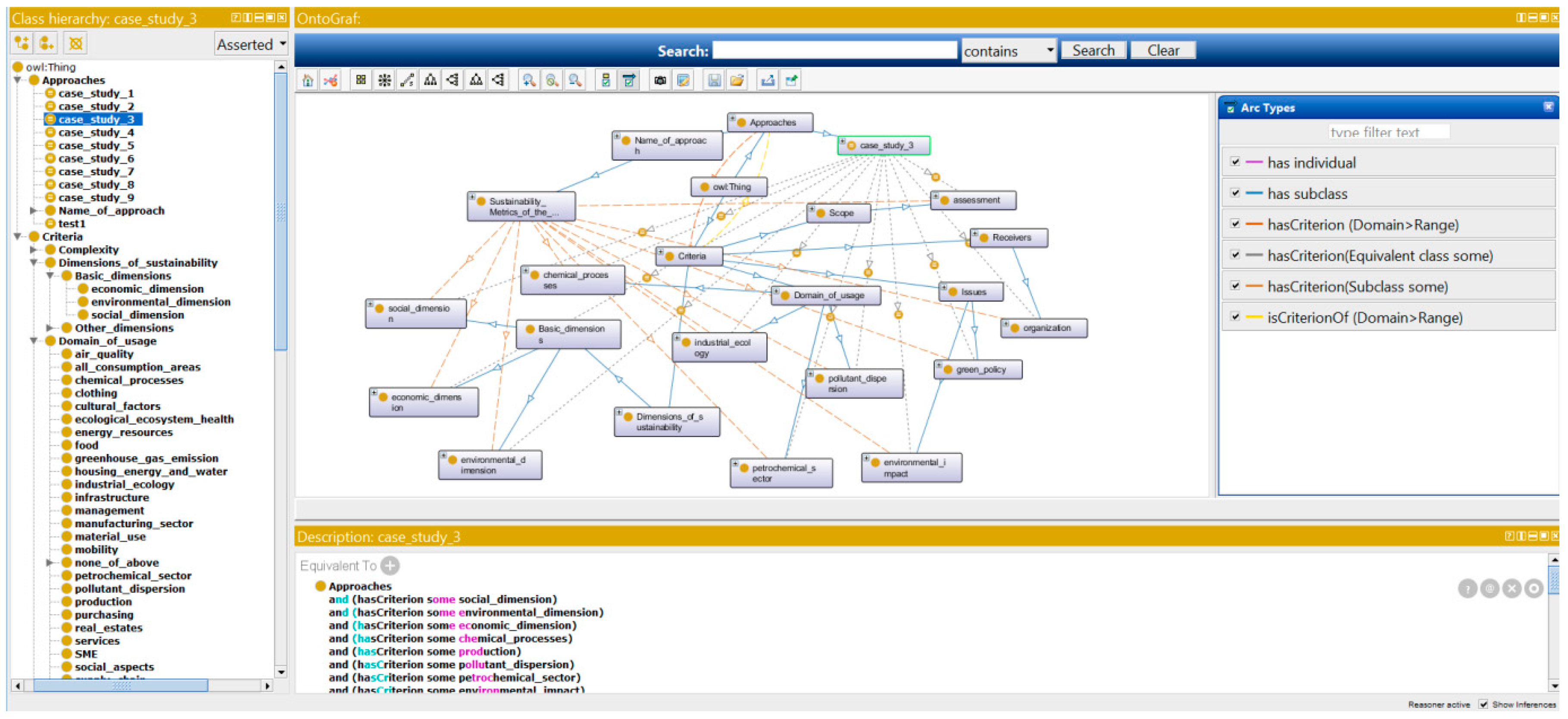

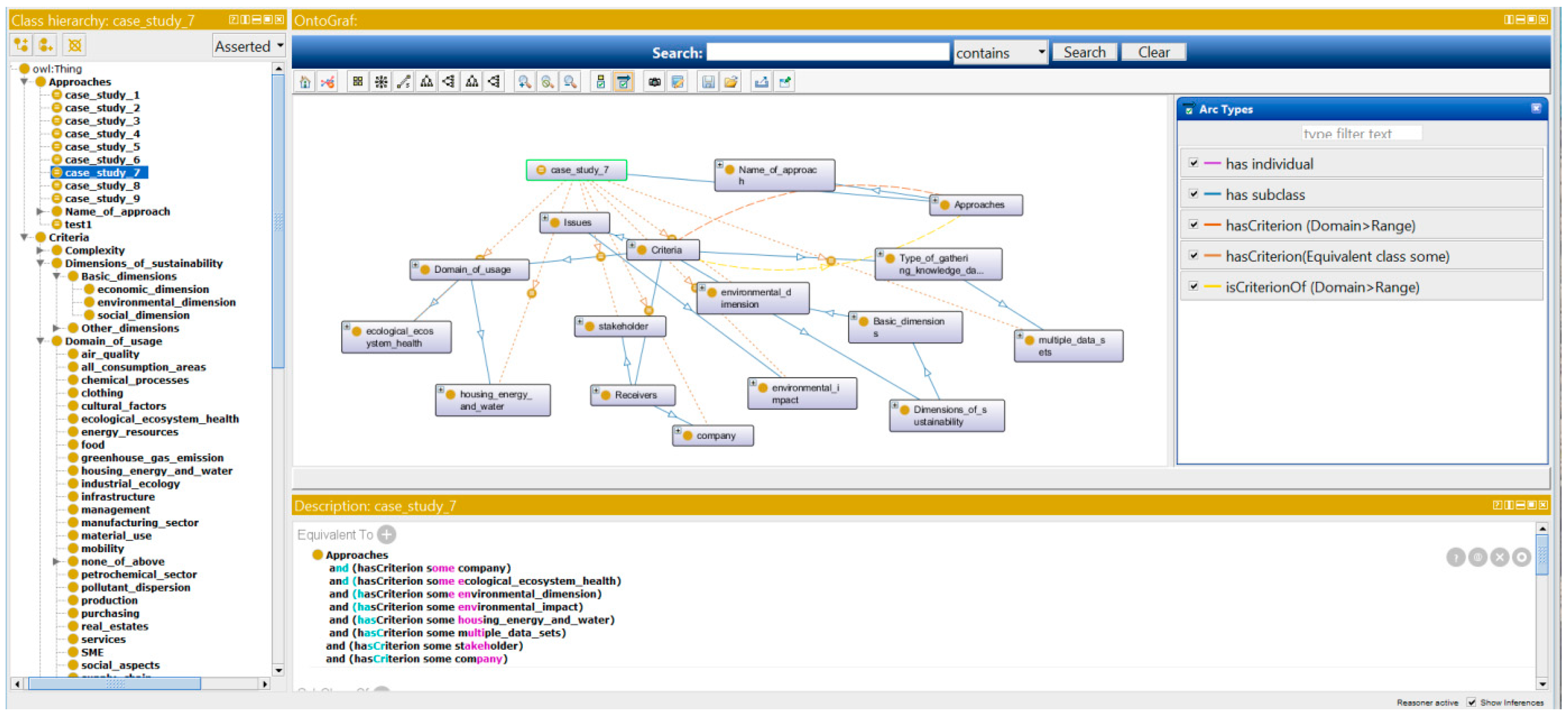
References
- Labuschagnea, C.; Brenta, A.C.; Ron, P.G.; Van Ercka, P.G. Assessing the sustainability performances of industries. J. Clean. Prod. 2005, 13, 373–385. [Google Scholar] [CrossRef]
- Jansen, R. Multi-Objective Decision Support for Environmental Management; Kluwer Academic Publishers: Dordrecht, The Netherlands, 1992; p. 248. ISBN 0-7923-1908-7. [Google Scholar]
- Sala, S.; Ciuffo, B.; Nijkamp, P. A systemic framework for sustainability assessment. Ecol. Econ. 2015, 119, 314–325. [Google Scholar] [CrossRef]
- Devuyst, D.; Hens, L.; de Lannoy, W. How Green Is the City? Sustainability Assessment and the Management of Urban Environments; Columbia University Press: New York, NY, USA, 2001; pp. 457–466. ISBN 9780231118033. [Google Scholar]
- Verheem, R. Recommendations for Sustainability Assessment in the Netherlands. In Environmental Impact Assessment in the Netherlands. Views from the Commission for EIA in 2002; Netherlands Commission for EIA: Utrecht, The Netherlands, 2002. [Google Scholar]
- Wackernagel, M.; Rees, W. Our Ecological Footprint: Reducing Human Impact on the Earth; Electronic New Society Publishers: Philadelphia, PA, USA, 1996; p. 160. ISBN 0-86571-312-X. [Google Scholar]
- Kates, R.W.; Clark, W.C.; Corell, R.; Hall, J.M.; Jaeger, C.C.; Lowe, I.; McCarthy, J.J.; Schellnhuber, H.J.; Bolin, B.; Dickson, N.M.; et al. Environment and development. Sustainability science. Science 2001, 292, 641–642. [Google Scholar] [CrossRef] [PubMed]
- Geiger, S.; Fischer, D.; Schrader, U. Measuring What Matters in Sustainable Consumption: An Integrative Framework for the Selection of Relevant Behaviors. Sustain. Dev. 2017. [Google Scholar] [CrossRef]
- Singh, R.K.; Murty, H.R.; Gupta, S.K.; Dikshit, A.K. An overview of sustainability assessment methodologies. Ecol. Indic. 2012, 15, 281–299. [Google Scholar] [CrossRef]
- Hermann, B.G.; Kroeze, C.; Jawjit, W. Assessing environmental performance by combining life cycle assessment, multi-criteria analysis and environmental performance indicators. J. Clean. Prod. 2007, 15, 1787–1796. [Google Scholar] [CrossRef]
- Sikdar, S.K. Sustainable Development and Sustainability Metrics. AIChE J. 2003, 49, 1928–1932. [Google Scholar] [CrossRef]
- Warhurst, A. Sustainability Indicators and Sustainability Performance Management; Report to the Project: Mining, Minerals and Sustainable Development (MMSD); International Institute for Environment and Development (IIED): Coventry, UK, 2002. [Google Scholar]
- Briassoulis, H. Sustainable development and its indicators: Through a (planner’s) glass darkly. J. Environ. Plan. Manag. 2001, 44, 409–427. [Google Scholar] [CrossRef]
- Miemczyk, J.; Johnsen, T.E.; Macquet, M. Sustainable purchasing and supply management: A structured literature review of definitions and measures at the dyad, chain and network levels. Supply Chain Manag. 2012, 17, 478–496. [Google Scholar] [CrossRef]
- Dreyer, L.C.; Hauschild, M.Z.; Schierbeck, J. A framework for social life cycle impact assessment. Int. J. Life Cycle Assess. 2006, 11, 88–97. [Google Scholar] [CrossRef]
- Moldan, B.; Janoušková, S.; Hák, T. How to understand and measure environmental sustainability: Indicators and targets. Ecol. Indic. 2012, 17, 4–13. [Google Scholar] [CrossRef]
- United Nations. Human Development Report; United Nations: New York, NY, USA, 2001; Available online: http://www.undp.org (accessed on 22 September 2017).
- Bohringer, C.; Jochem, P.E.P. Measuring the immeasurable—A survey of sustainability indices. Ecol. Econ. 2007, 63, 1–8. [Google Scholar] [CrossRef]
- Jung, E.J.; Kim, J.S.; Rhee, S.K. The measurement of corporate environmental performance and its application to the analysis of efficiency in oil industry. J. Clean. Prod. 2001, 9, 551–563. [Google Scholar] [CrossRef]
- Jackson, T. Sustainable consumption. In Handbook of Sustainable Development; Atkinson, G., Dietz, S., Neumeyer, E., Eds.; Elgar: Cheltenham, UK, 2007; pp. 254–268. ISBN 978-1-84844-472-0. [Google Scholar]
- Hertwich, E.G. Life cycle approaches to sustainable consumption: A critical review. Environ. Sci. Technol. 2005, 39, 4673–4684. [Google Scholar] [CrossRef] [PubMed]
- Heiskanen, E.; Mont, O. Power KA map is not a territory—Making research more helpful for sustainable consumption policy. J. Consum. Policy 2014, 37, 27–44. [Google Scholar] [CrossRef]
- Holden, E.; Linnerud, K.; Banister, D. The imperatives of sustainable development. Sustain. Dev. 2016, 25, 213–226. [Google Scholar] [CrossRef]
- Wang, T.-K.; Zhang, Q.; Chong, H.-Y.; Wang, X. Integrated Supplier Selection Framework in a Resilient Construction Supply Chain: An Approach via Analytic Hierarchy Process (AHP) and Grey Relational Analysis (GRA). Sustainability 2017, 9, 289. [Google Scholar] [CrossRef]
- Teece, D.J. Explicating dynamic capabilities: The nature and microfoundations of (sustainable) enterprise performance. Strateg. Manag. J. 2007, 28, 1319–1350. [Google Scholar] [CrossRef]
- Eisenmenger, N.; Giljum, S.; Lutter, S.; Marques, A.; Theurl, M.C.; Pereira, H.M.; Tukker, A. Towards a Conceptual Framework for Social-Ecological Systems Integrating Biodiversity and Ecosystem Services with Resource Efficiency Indicators. Sustainability 2016, 8, 201. [Google Scholar] [CrossRef]
- Dholakia, R.; Wackernagel, M. The Ecological Footprint Questionnaire; Redefining Progress: San Francisco, CA, USA, 1999. [Google Scholar]
- Bebbington, J.; Brown, J.; Frame, B. Accounting technologies and sustainability assessment models. Ecol. Econ. 2007, 61, 224–236. [Google Scholar] [CrossRef]
- Veleva, V.; Ellenbecker, M. Indicators of sustainable production: Framework and methodology. J. Clean. Prod. 2001, 9, 519–549. [Google Scholar] [CrossRef]
- Kuik, O.J.; Gilbert, A.J. Indicators of sustainable development. In Handbook of Environmental and Resource Economics; Van den Bergh, J.C.J.M., Ed.; Edward Elgar: Cheltenham, UK, 1999; pp. 722–730. ISBN 978-1-85898-375-2. [Google Scholar]
- Savić, D.; Veljko, J.; Petrovic, N. Rebuilding the Pillars of Sustainable Society Index: A Multivariate Post Hoc I-Distance Approach. Probl. Ekorozw. Probl. Sustain. Dev. 2016, 12, 125–134. [Google Scholar]
- Sustainable Society Index (SSI). Available online: http://www.ssfindex.com (accessed on 18 September 2017).
- Cuthill, M. Strengthening the ‘social’ in sustainable development: Developing a conceptual framework for social sustainability in a rapid urban growth region in Australia. Sustain. Dev. 2010, 18, 362–373. [Google Scholar] [CrossRef]
- Spohn, O.M. Sustainable Development Indicators within the German Water Industry—A Case Study; Carried out at Chalmers University of Technology; Chalmers University of Technology: Gothenburg, Sweden, 2004. [Google Scholar]
- Hofstede, G. Dimensionalizing Cultures: The Hofstede Model in Context. Online Read. Psychol. Cult. 2011, 2. [Google Scholar] [CrossRef]
- Ranganathan, J. Sustainability Rulers: Measuring Corporate Environmental & Social Performance; Sustainable Enterprise Perspectives; World Resources Institute: Washington, DC, USA, 1998. [Google Scholar]
- Lundin, U. Indicators for Measuring the Sustainability of Urban Water Systems—A Life Cycle Approach. Ph.D. Thesis, Department of Environmental Systems Analysis, Chalmers University of Technology, Göteborg, Sweden, 2003. [Google Scholar]
- KEI, Knowledge Economy Indicators. Work Package 7, State of the Art Report on Simulation and Indicators; European Commission: Brussels, Belgium, 2005. [Google Scholar]
- Berke, P.; Manta, M. Planning for Sustainable Development: Measuring Progress in Plans; Working Paper; Lincoln Institute of Land Policy: Cambridge, MA, USA, 1999. [Google Scholar]
- Crnogaj, K.; Rebernik, M.B.; Hojnik, B.; Omerzel, G.D. Building a model of researching the sustainable entrepreneurship in the tourism sector. Kybernetes 2014, 43, 377–393. [Google Scholar] [CrossRef]
- Meadows, D. Indicators and Information Systems for Sustainable Development—A Report to the Balaton Group; The Sustainability Institute: Hartland, WI, USA, 1998; Available online: http://www.sustainabilityinstitute.org/resources.html#SIpapers (accessed on 13 September 2017).
- Van de Kerk, G.; Manuel, A. Sustainable Society Index 2016; Sustainable Society Foundation: The Hague, The Netherlands, 2016; Available online: http://www.ssfindex.com (accessed on 13 September 2017).
- IChemE—Institution of Chemical Engineers, Institution of Chemical Engineers. Sustainable Development Progress Metrics. 2002. Available online: http://www.icheme.org/sustainability/metrics.pdf (accessed on 13 September 2017).
- Hsu, A.; Zomer, A. Environmental Performance Index. Wiley StatsRef: Statistics Reference Online: 2016. pp. 1–5. Available online: http://onlinelibrary.wiley.com/doi/10.1002/9781118445112.stat03789.pub2/abstract (accessed on 23 December 2017).
- Osberg, L.; Sharpe, A. International comparisons of trends in economic well-being. Soc. Indic. Res. 2002, 58, 349–382. [Google Scholar] [CrossRef]
- Emerson, J.W.; Hsu, A.; Levy, M.A.; de Sherbinin, A.; Mara, V.; Esty, D.C. Environmental Performance Index and Pilot Trend Environmental Performance Index; Yale Center for Environmental Law and Policy: New Haven, CT, USA, 2012; pp. 1–99. [Google Scholar]
- Tanzil, D.; Beaver, E.R.; Heine, L.; Abraham, M.A. Designing for Sustainability. In Transforming Sustainability Strategy into Action: The Chemical Industry; Beloff, B., Lines, M., Tanzil, D., Eds.; John Wiley & Sons, Inc.: Hoboken, NJ, USA, 2005. [Google Scholar] [CrossRef]
- Camison, C. Learning for environmental adaptation and knowledge-intensive services: The role of public networks for SMEs. Serv. Ind. J. 2008, 28, 827–844. [Google Scholar] [CrossRef]
- Darnall, N.; Jolley, G.J.; Handfield, R. Environmental management systems and green supply chain management: Complements for sustainability? Bus. Strateg. Environ. 2008, 17, 30–45. [Google Scholar] [CrossRef]
- Maignan, I.; Hillebrand, B.; McAlister, D. Managing socially-responsible buying: How to integrate non-economic criteria into the purchasing process. Eur. Manag. J. 2002, 20, 641–648. [Google Scholar] [CrossRef]
- Holt, D.; Ghobadian, A. An empirical study of green supply chain management practices amongst UK manufacturers. J. Manuf. Technol. Manag. 2009, 20, 933–956. [Google Scholar] [CrossRef]
- Carter, C.R.; Jennings, M.M. The role of purchasing in corporate social responsibility: A structural equation analysis. J. Bus. Logist. 2000, 25, 145–186. [Google Scholar] [CrossRef]
- Eltayeb, T.K.; Zailani, S.; Jayaraman, K. The examination on the drivers for green purchasing adoption among EMS 14001 certified companies in Malaysia. J. Manuf. Technol. Manag. 2010, 21, 206–225. [Google Scholar] [CrossRef]
- Koplin, J.; Seuring, S.; Mesterharm, M. Incorporating sustainability into supply management in the automotive industry: The case of the Volkswagen AG. J. Clean. Prod. 2007, 15, 1053–1062. [Google Scholar] [CrossRef]
- Thun, J.R.-H.; Mueller, A. An empirical analysis of green supply chain management in the German automotive industry. Bus. Strateg. Environ. 2010, 19, 119–132. [Google Scholar] [CrossRef]
- Rao, P.; Holt, D. Do green supply chains lead to competitiveness and economic performance? Int. J. Oper. Prod. Manag. 2005, 25, 898–916. [Google Scholar] [CrossRef]
- Zhu, Q.; Sarkis, J.; Geng, Y. Green supply chain management in China: Pressures, practices and performance. Int. J. Oper. Prod. Manag. 2005, 25, 449–468. [Google Scholar] [CrossRef]
- Vachon, S.; Mao, Z. Linking supply chain strength to sustainable development: A country-level analysis. J. Clean. Prod. 2008, 16, 1552–1560. [Google Scholar] [CrossRef]
- Seuring, S.; Muller, M. From a literature review to a conceptual framework for sustainable supply chain management. J. Clean. Prod. 2008, 16, 1699–1710. [Google Scholar] [CrossRef]
- Sustainability Index. Available online: https://www.aiche.org/ifs/resources/sustainability-index (accessed on 10 July 2017).
- Ziemba, P.; Wątróbski, J.; Zioło, M.; Karczmarczyk, A. Using the PROSA Method in Offshore Wind Farm Location Problems. Energies 2017, 10, 1755. [Google Scholar] [CrossRef]
- Schwartz, J.; Beloff, B.; Beaver, E. Use Sustainability Metrics to Guide Decision-Making. Chem. Eng. Prog. 2002, 98, 58–63. [Google Scholar]
- Fiksel, J. Designing Resilient, Sustainable Systems. Environ. Sci. Technol. 2003, 37, 5330–5339. [Google Scholar] [CrossRef] [PubMed]
- EUROSTAT: Sustainable Development Indicators. Available online: http://ec.europa.eu/eurostat/web/sdi/indicators (accessed on 13 August 2017).
- Yang, W.; McKinnon, M.C.; Turner, W.R. Quantifying human well-being for sustainability research and policy. Ecosyst. Health Sustain. 2015, 1, 1–13. [Google Scholar] [CrossRef]
- Wu, K.J.; Liao, C.J.; Tseng, M.L.; Lim, M.K.; Hu, J.; Tan, K. Toward sustainability: Using Big Data to Explore the Decisive Attributes of Supply Chain Risks and Uncertainties. J. Clean. Prod. 2017, 142, 663–676. [Google Scholar] [CrossRef]
- Hosseininia, G.; Ramezani, A. Factors Influencing Sustainable Entrepreneurship in Small and Medium-Sized Enterprises in Iran: A Case Study of Food Industry. Sustainability 2016, 8, 1010. [Google Scholar] [CrossRef]
- Bengtsson, M.; Steen, B. Weighting in LCA—Approaches and applications. Environ. Prog. Sustain. 2000, 19, 101–109. [Google Scholar] [CrossRef]
- Batra, S. Sustainable Entrepreneurship and Knowledge Based Development. In Proceedings of the Eleventh International Entrepreneurship Forum, Kuala Lumpur, Malaysia, 3–6 September 2012; pp. 2–30. [Google Scholar]
- Ireland, R.D.; Hitt, M.A.; Sirmon, D.G. A Model of Strategic Entrepreneurship: The Construct and its Dimensions. J. Manag. 2003, 29, 963–989. [Google Scholar] [CrossRef]
- Belkadi, F.; Alain, B.; Florent, L. Knowledge Based and PLM Facilities for Sustainability Perspective in Manufacturing: A Global Approach. Procedia CIRP 2015, 29, 203–208. [Google Scholar] [CrossRef]
- Monticolo, D.; Lahoud, B.E. SemKnow: A Multi-Agent Platform to manage distributed knowledge by using ontologies. In Proceedings of the 2012 IAENG International Conference on Artificial Intelligence and Applications (ICAIA 2012), Hong Kong, China, 14–16 March 2012. [Google Scholar]
- Noy, N.; McGuiness, D. Ontology Development 101: A Guide to Creating Your First Ontology; Technical Report KSL-01-05 and Stanford Medical Informatics Technical Report SMI-2001-0880; Stanford Knowledge Systems Laboratory: Stanford, CA, USA, 2001. [Google Scholar]
- Uschold, M.; King, M. Towards a Methodology for Building Ontologies. In Proceedings of the IJCAI’95 Workshop on Basic Ontological Issues in Knowledge Sharing, Montreal, QC, Canada, 20–25 August 1995; Skuce, D., Ed.; Artificial Intelligence Applications Institute: Edinburgh, UK; pp. 6.1–6.10. [Google Scholar]
- Grüninger, M.; Fox, M.S. Methodology for the design and evaluation of ontologies. In Proceedings of the IJCAI’95 Workshop on Basic Ontological Issues in Knowledge Sharing, Montreal, QC, Canada, 20–25 August 1995; Skuce, D., Ed.; Artificial Intelligence Applications Institute: Edinburgh, UK; pp. 6.1–6.10. [Google Scholar]
- Fernández-López, M.; Gómez-Pérez, A.; Juristo, N. Methontology: From Ontological Art towards Ontological Engineering. In Proceedings of the Spring Symposium on Ontological Engineering of AAAI, Stanford University, Stanford, CA, USA, 24–26 March 1997; pp. 33–40. [Google Scholar]
- Staab, S.; Schnurr, H.P.; Studer, R.; Sure, Y. Knowledge Processes and Ontologies. IEEE Intell. Syst. 2001, 16, 26–34. [Google Scholar] [CrossRef]
- Hacking, T.; Guthrie, P. A framework for clarifying the meaning of triple bottom-line, integrated and sustainability assessment. Environ. Impact Assess. Rev. 2008, 28, 73–89. [Google Scholar] [CrossRef]
- WCDE (World Commission on Environment and Development). Our Common Future; Oxford University Press: Oxford, UK, 1987. [Google Scholar]
- Uhlman, B.W.; Saling, P. Measuring and communicating sustainability through eco-efficiency analysis. Chem. Eng. Prog. 2010, 106, 17–26. [Google Scholar]
- Brown, K.W.; Kasser, T. Mindful Climate Action: Health and Environmental Co-Benefits from Mindfulness-Based Behavioral Training. Soc. Indic. Res. 2005, 74, 349. [Google Scholar] [CrossRef]
- Norris, K.; Jacobson, S. Content analysis of tropical education programs: Elements of success. J. Environ. Educ. 1998, 30, 38–44. [Google Scholar] [CrossRef]
- Wątróbski, J.; Ziemba, P.; Jankowski, J.; Zioło, M. Green Energy for a Green City—A Multi-Perspective Model Approach. Sustainability 2016, 8, 702. [Google Scholar] [CrossRef]
- Centobelli, P.; Cerchione, R.; Esposito, E. Knowledge Management in Startups: Systematic Literature Review and Future Research Agenda. Sustainability 2017, 9, 361. [Google Scholar] [CrossRef]
- Coldwell, D. Entropic Citizenship Behavior and Sustainability in Urban Organizations: Towards a Theoretical Model. Entropy 2016, 18, 453. [Google Scholar] [CrossRef]
- Carter, R.C.; Rogers, D.S. A framework of sustainable supply chain management: Moving toward new theory. Int. J. Phys. Distrib. Logist. 2008, 38, 360–387. [Google Scholar] [CrossRef]
- Balderjahn, I.; Buerke, A.; Kirchgeorg, M.; Peyer, M.; Seegebarth, B.; Wiedmann, K.P. Consciousness for sustainable consumption: Scale development and new insights in the economic dimension of consumers’ sustainability. AMS Rev. 2013, 3, 181. [Google Scholar] [CrossRef]
- Pepper, M.; Jackson, T.; Uzzell, D. An examination of the values that motivate socially conscious and frugal consumer behaviours. Int. J. Consum. Stud. 2009, 33, 126–136. [Google Scholar] [CrossRef]
- Gilg, A.; Barr, S.; Ford, N. Green consumption or sustainable lifestyles? Identifying the sustainable consumer. Futures 2005, 37, 481–504. [Google Scholar] [CrossRef]
- Wackernagel, M.; Yount, J.D. Footprints for sustainability: The next steps. Environ. Dev. Sustain. 2000, 2, 21–42. [Google Scholar] [CrossRef]
- Richomme-Huet, K.; Freyman, J.D. What Sustainable Entrepreneurship Looks Like: An Exploratory Study from a Student Perspective. In Proceedings of the 56th Annual International Council for Small Business (ICSB) World Conference, Stockholm, Sweden, 15–18 June 2011. [Google Scholar]
- Husin, S.N.F.S.; Harith, Z.Y.H. The performance of daylight through various type of fenestration in residential building. Procedia Soc. Behav. Sci. 2012, 36, 196–203. [Google Scholar] [CrossRef]
- Kristensen, P. The DPSIR Framework; National Environmental Research Institute: Nyborg, Denmark; European Topic Centre, European Environment Agency: Copenhagen, Denmark, 2004. [Google Scholar]
- Bialas, A. Computer-aided sensor development focused on security issues. Sensors 2016, 16, 759. [Google Scholar] [CrossRef] [PubMed]
- Medina-Oliva, G.; Voisin, A.; Monnin, M.; Leger, J.B. Predictive diagnosis based on a fleet-wide ontology approach. Knowl. Based Syst. 2014, 68, 40–57. [Google Scholar] [CrossRef]
- Maleki, E.; Belkadi, F.; Ritou, M.; Bernard, A. A Tailored Ontology Supporting Sensor Implementation for the Maintenance of Industrial Machines. Sensors 2017, 17, 2063. [Google Scholar] [CrossRef] [PubMed]
- Gruber, T.R. A Translation Approach to Portable Ontology Specification. Knowl. Acquis. 1993, 5, 199–220. [Google Scholar] [CrossRef]
- Barbau, R.; Krima, S.; Rachuri, S.; Narayanan, A.; Fiorentini, X.; Foufou, S.; Sriram, R.D. OntoSTEP: Enriching product model data using ontologies. Comput. Aided Des. 2012, 44, 575–590. [Google Scholar] [CrossRef]
- Fowler, J.W.; Rose, O. Grand challenges in modelling and simulation of complex manufacturing systems. Simulation 2004, 80, 469–476. [Google Scholar] [CrossRef]
- Musen, M.A. The Protégé project: A look back and a look forward. AI Matters 2015, 1. [Google Scholar] [CrossRef] [PubMed]
- Baader, F.; Calvanese, D.; McGuinness, D.; Nardi, D.; Patel-Schneider, P.F. The Description Logic Handbook: Theory, Implementation and Applications; Cambridge University Press: Cambridge, UK, 2003; ISBN 0-521-78176-0. [Google Scholar]
- Norris, G.A. Integrating Life Cycle Cost Analysis and LCA. Int. J. LCA 2001, 6, 118. [Google Scholar] [CrossRef]
- Asiedu, Y.; Gu, P. Product life cycle cost analysis: State of the art review. Int. J. Prod. Res. 1998, 36, 4. [Google Scholar] [CrossRef]
- Tsuda, M.; Takaoka, M. Novel evaluation method for social sustainability affected by using ICT services. In Proceedings of the International Life Cycle Assessment & Management Conference, Washington, DC, USA, 4–6 October 2006. [Google Scholar]
- Kaiser, F.G.; Wilson, M. Goal-directed conservation behaviour: The specific composition of a general performance. Personal. Indivd. Differ. 2004, 36, 1531–1544. [Google Scholar] [CrossRef]
- Gatersleben, B.; Steg, L.; Vlek, C. The measurement and determinants of environmentally significant consumer behavior. Environ. Behav. 2002, 34, 335–362. [Google Scholar] [CrossRef]
- Krstić, B.; Jovanović, S.; Janković-Milić, V. Sustainability Performance Management System of Tourism Enterprises. Facta Univ. 2008, 5, 123–131. [Google Scholar]
- United Nations Division for Sustainable Development (UNDSD). Indicators of Sustainable Development: Guidelines and Methodologies. Available online: http://www.un.org/esa/sustdev/publications/indisd-mg2001.pdf (accessed on 11 July 2017).
- Hutchins, M.; Sutherland, J. Exploration of measures of social sustainability and their application to supply chain decisions. J. Clean. Prod. 2008, 16, 1688–1698. [Google Scholar] [CrossRef]
- Global Reporting Initiative. Sustainability Reporting Guidelines: Exposure Draft for Public Comment and Pilot-Testing; Sustainable Measures: Evaluation and Reporting of Environmental and Social Performance; Greenleaf Publishing in Association with GSE Research: Boston, MA, USA, 1999; Volume 440, No. 474; pp. 440–474. [Google Scholar]
- Berger-Schmitt, R.; Noll, H.H. Conceptual Framework and Structure of a European System of Social Indicators; EuReporting Working Paper no. 9; Centre for Survey Research and Methodology (ZUMA): Mannheim, Germany, 2000. [Google Scholar]

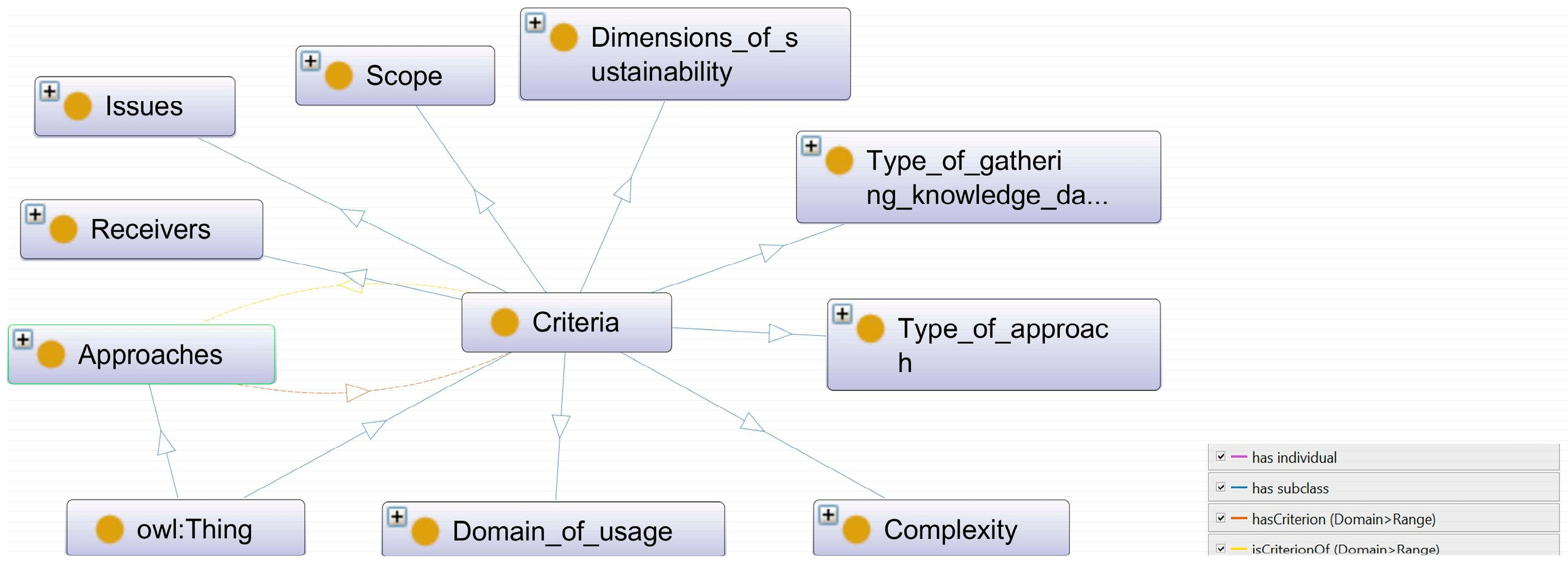
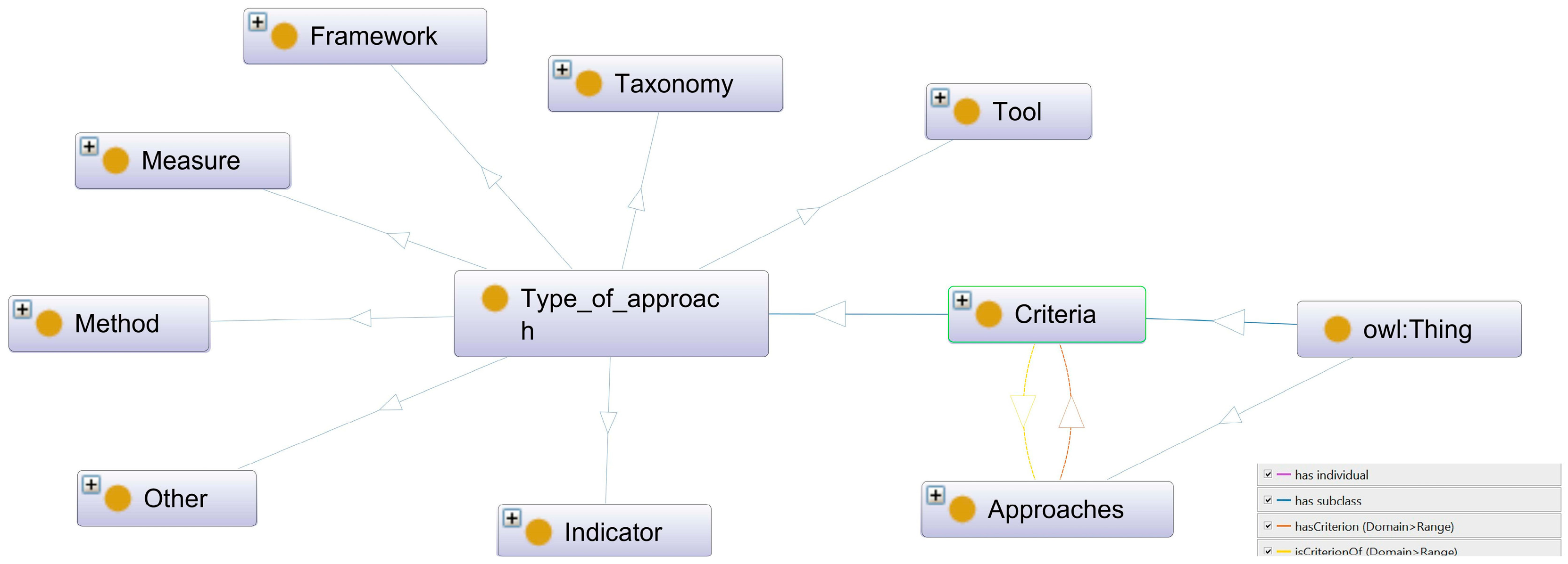
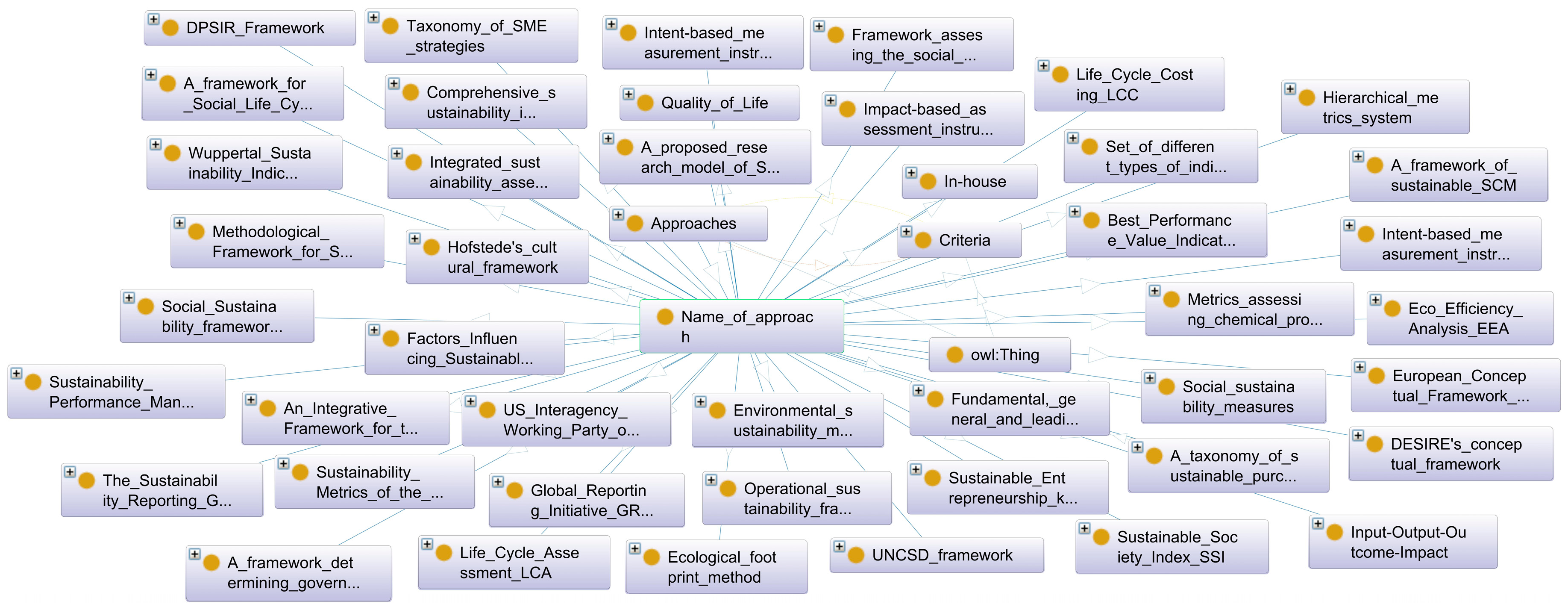
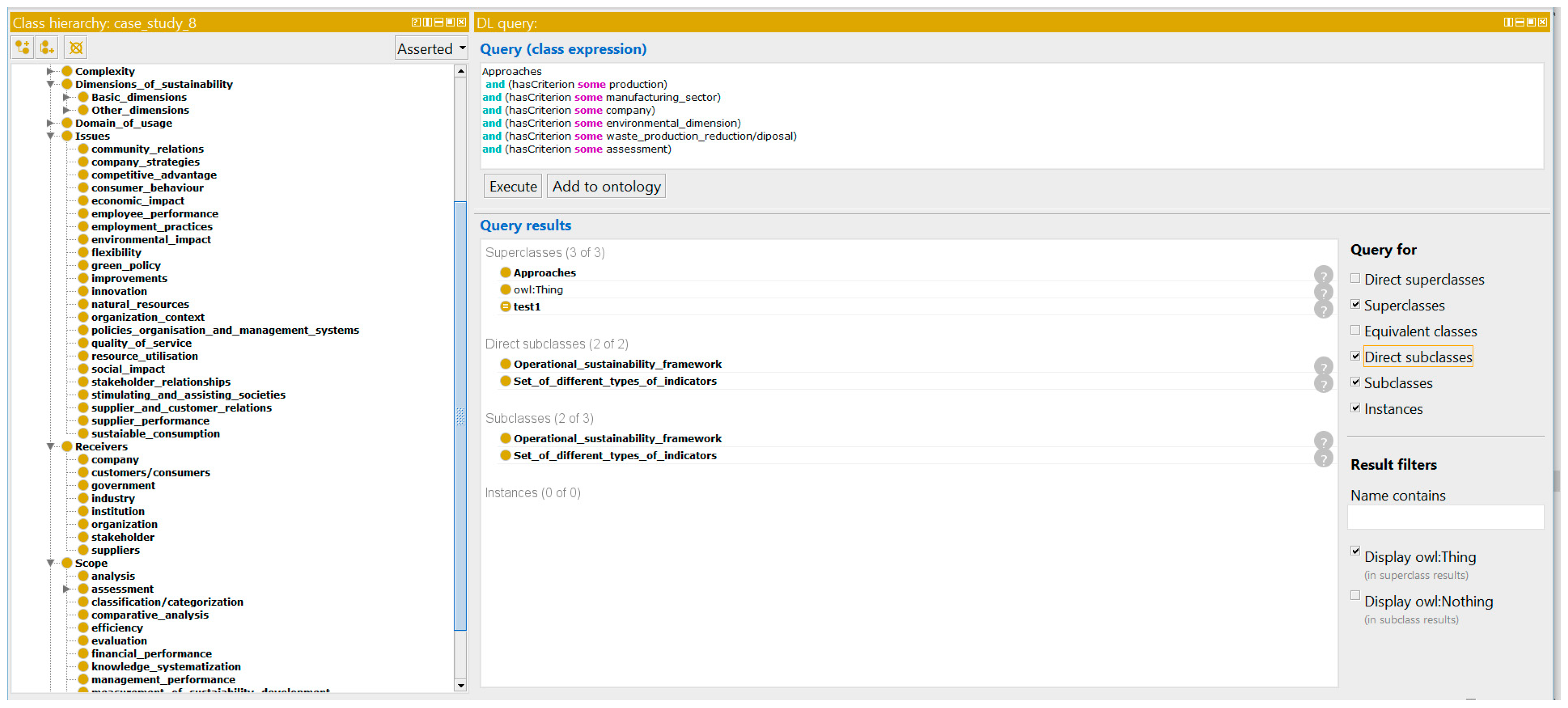
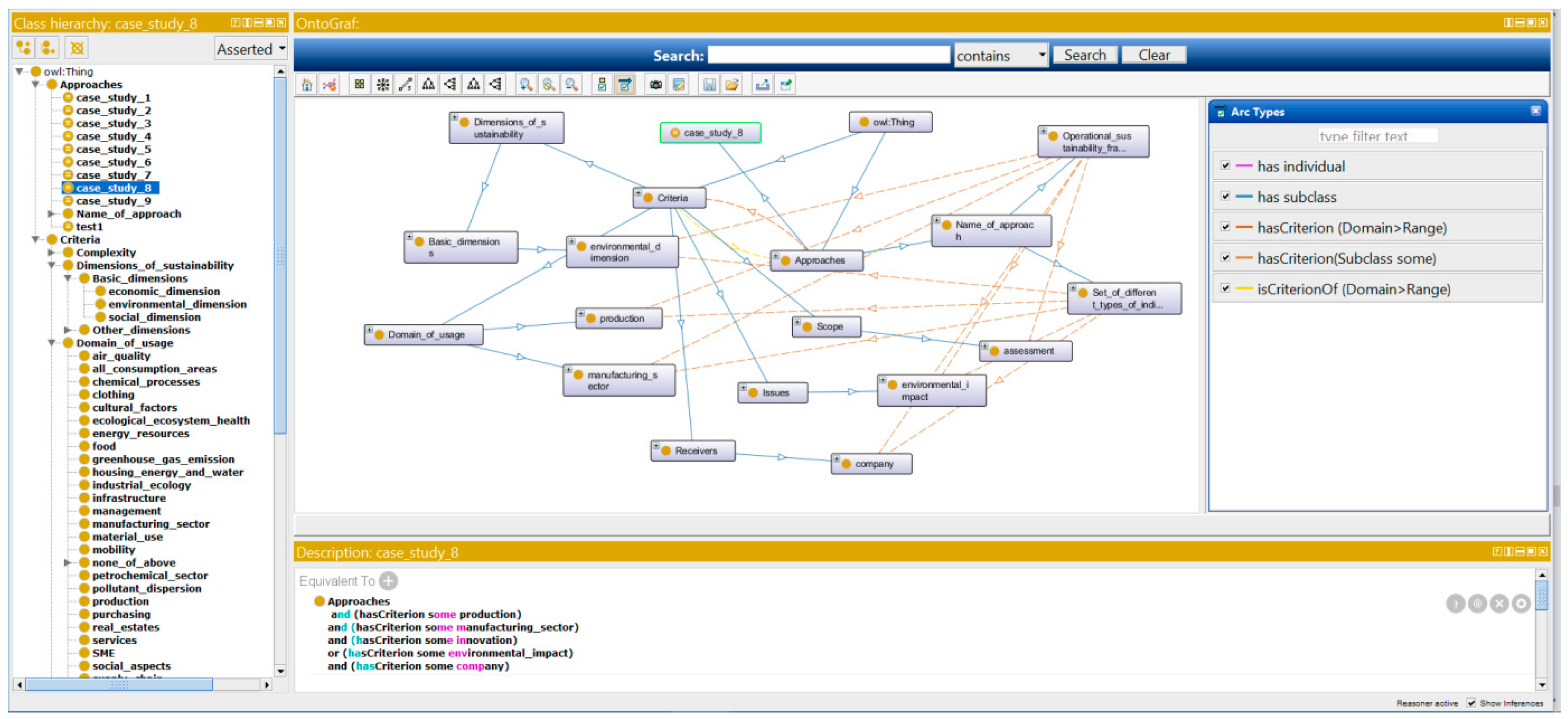
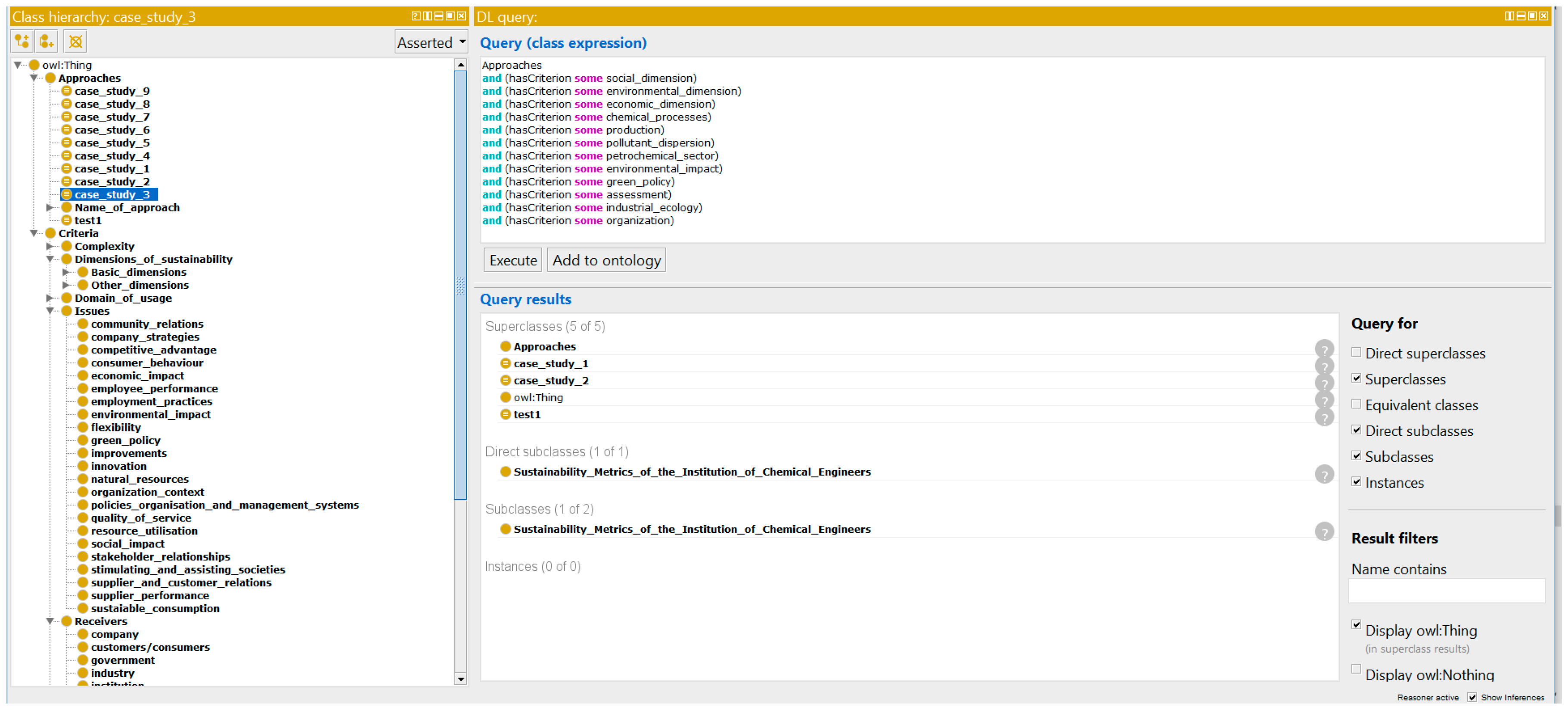
© 2018 by the author. Licensee MDPI, Basel, Switzerland. This article is an open access article distributed under the terms and conditions of the Creative Commons Attribution (CC BY) license (http://creativecommons.org/licenses/by/4.0/).
Share and Cite
Konys, A. An Ontology-Based Knowledge Modelling for a Sustainability Assessment Domain. Sustainability 2018, 10, 300. https://doi.org/10.3390/su10020300
Konys A. An Ontology-Based Knowledge Modelling for a Sustainability Assessment Domain. Sustainability. 2018; 10(2):300. https://doi.org/10.3390/su10020300
Chicago/Turabian StyleKonys, Agnieszka. 2018. "An Ontology-Based Knowledge Modelling for a Sustainability Assessment Domain" Sustainability 10, no. 2: 300. https://doi.org/10.3390/su10020300
APA StyleKonys, A. (2018). An Ontology-Based Knowledge Modelling for a Sustainability Assessment Domain. Sustainability, 10(2), 300. https://doi.org/10.3390/su10020300



